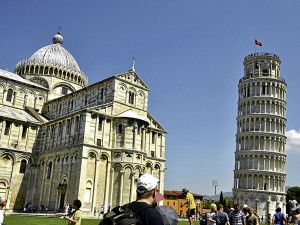Countless stories and blogs may have been written about Tuscany in Italy. And there certainly is a reason for that. This region of Italy, recognized as most beautiful, is not just a magnet for tourists but also for admirers of history and its structures. This writer was fortunate to visit some areas here and get a glimpse of some of its amazing structures.
A solo tour costing 58 euros (around P3,500) led this writer to Florence (Italian: Firenze) from Milan. It wasn’t my first time here, but I was still enchanted by the place, still gawking at the palaces surrounding the Piazza della Signoria. The attention to details by its creators is a visual feast and a discussion-inducing addition to Florence’s architectural history.
Inside, it’s heaven for shutterbugs as art monuments are ready for the taking—of pictures, that is. The Loggia dei Lanzi, for instance, is made of three large arches with elegant tiles above the pillars and two lion monuments at the side of the stairs.
Seat of town events
Historical data from Officina Grafica Bolognese in Bologna, Italy relate that the Loggia dei Lanzi was built between 1376 and 1391 by Benci di Cione and Simone Talenti in late Florentine Gothic style as the seat of the most important town events. It cited as an example the election of the Priors and of the Gonfalioner. The name Dei Lanzi derives from the fact that the Loggia was occupied by the Lansquenet army.
Palazzo Vecchio is known as a fortress-palace. Its construction started in 1294 by Arnolfo di Cambio and was later enlarged by Buontalenti and Vasari. It was conceived to be the residence of the Priors. Officina Grafica Bolognese stressed that as a fortress-palace, it does in fact appear to be a monolithic bloc interrupted by two levels of elegant windows with two lights and an imposing crenellated terrace which is surmounted by the strong double-crenellated tower called d’ Arnolfo.
THE TOWER’S maximum height is 56.70 m; the outer diameter of the base is 15.48 m; the inner diameter is 57.37 m.
A nice courtyard welcomes visitors to the Palazzo. This is surrounded by an elegant porch, which was restored by Michelozzo in 1453. A fountain surmounted by a bronze putto or infant boy was created by Andrea del Verrocchio.
For about 7.5 euros (a little over P450) transport fare from Firenze, curiosity got the better of me as I decided to check on Pisa. And it is in Piazza dei Miracoli which offers most of the famous structures and monuments in Pisa, once known as one of the greatest maritime powers of the Mediterranean.
The Hanging Tower of Pisa (known to most as the Leaning Tower of Pisa) has been called one of the world’s seven wonders. “The main particularity is its gradient, certainly due to a collapse of the ground (that) occurred during its building in Romanesque style, which started in 1174 under the direction of Bonanno Pisano,” Officina Grafica Bolognese wrote.
Historical data reveal that during the course of time, the tower has continued to increase its gradient (or leaning) by about 1 mm a year, so much so that in these last few years, it has been necessary to intervene to stop it from toppling over.
Reinforced concrete has been injected under the base of the hanging side, whereas big steel tie beams have been applied to the opposite side.
“The possible fall of the Tower would in fact be a huge catastrophe, in that, beyond losing one of the world’s seven wonders, we would also lose all the surrounding monuments,” Officina Grafica Bolognese said.
photos by Tessa R. Salazar
